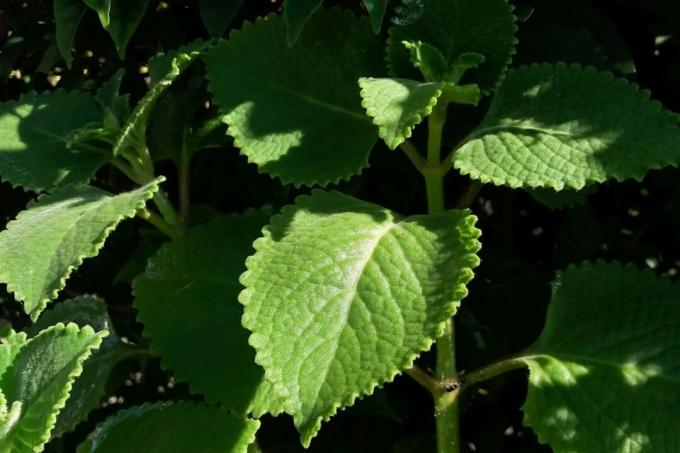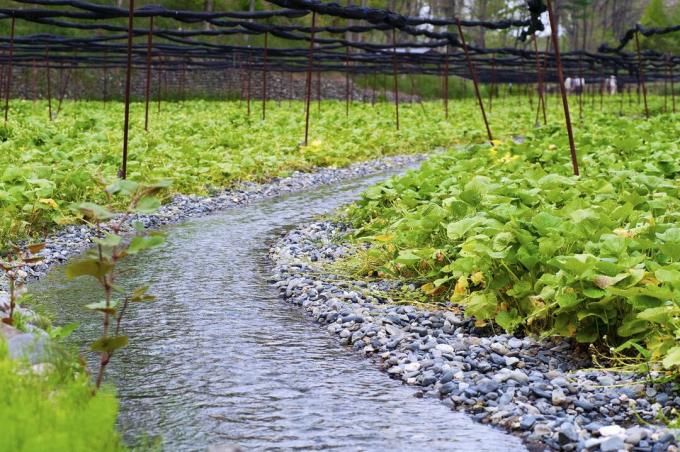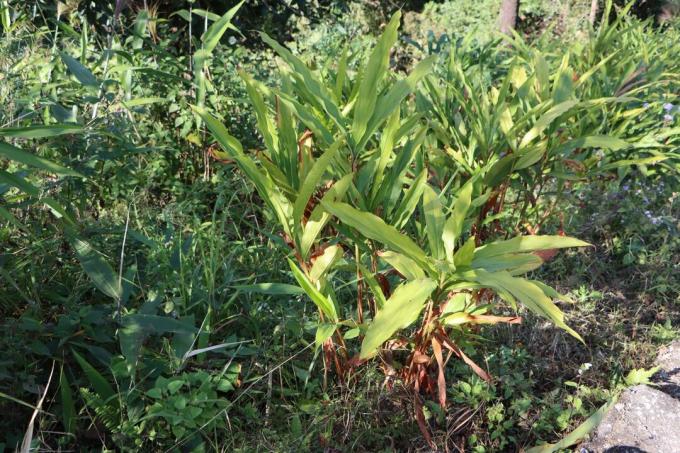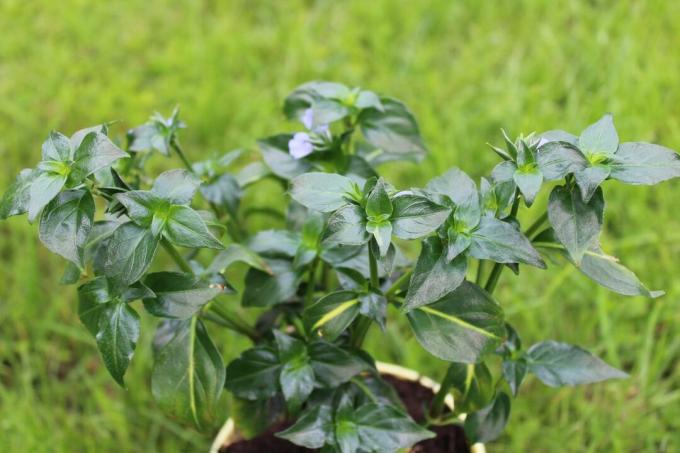All plants need light to grow, but some need less than others. Here you will find suggestions for herbs that grow in the shade and are suitable for the garden or balcony.

They are in every garden. The shady spots where nothing really wants to grow. Most well-known herbs feel most comfortable in the sun, but apart from oregano, basil and the like, there are also some interesting herbs for the shade.
contents
-
Herbs for shade that are hardy
- wild garlic (Allium ursinum)
- Perennial borage (Borago pygmaea)
- Woodruff (Galium odoratum)
- Lesser Calamint (Calamintha nepeta)
- Watercress (Nasturtium officinalis)
- Wasabi, Japanese horseradish (Wasabia japonica)
- Yellow Sage (Salvia glutinosa)
-
Herbs for shade that are not hardy
- Vietnamese coriander (Polygonum odoratum)
- Gotu Kula (Centella asiatica)
- Cardamom (Elettaria cardamomum)
- Mushroom Plant (Rungia klossii)
Herbs for shade that are hardy
Below are some herbs that tolerate shade well and can be grown outside in the garden as they are hardy.
wild garlic (Allium ursinum)
If you go hiking in May, the scent of wild garlic in the air. Its preference for shade is also evident in nature, as it is mainly found in forests, in rather damp and nutrient-rich locations. If you bring wild garlic into your garden, you can avoid the risk of confusion with lily of the valley, which often occurs when collecting in the forest.

Perennial Borage (Borago pygmaea)
It is the little, perennial brother of the common one, which is known and used in Germany borage. The perennial borage prefers loose, well-drained soil. Although he likes the sun more, there is also an advantage to planting the herb in the shade. That is where the leaves become more tender. Thanks to its small growth, it is also ideal if you are looking for herbs for a shady balcony. The perennial borage can withstand frosts down to -10 °C, which is why it should be covered with brushwood in very cold winters.

woodruff (Galium odoratum)
It is known for its sherbet powder, jelly pudding or the notorious May punch. woodruff is, along with wild garlic, one of the few herbs that really likes the shade and doesn't tolerate the sun. If it likes its location, which is best with moist, humus-rich and calcareous soil, it can quickly gain the upper hand and spread extensively via root runners. This can be prevented by a root barrier.

Little Calamint (Calamintha nepeta)
Unlike peppermints, calamints do not form runners and are therefore easier to keep under control. Thanks to its compact growth, the small calamint is also one of the herbs for shady balconies. Its leaves can be used like peppermints and its flowers act as a real insect magnet. It prefers a dry and rather nutrient-poor location.

watercress (Nasturtium officinalis)
An evergreen shade herb whose leaves can be used in a variety of ways in the kitchen is the watercress. In winter, the plant is also an important source of vitamin C. However, it needs a very moist location, preferably even in running water, which can only be found in a few gardens.

Wasabi, Japanese horseradish (Wasabia japonica)
the wasabi is one of the shade herbs, because its leaves often turn yellow in the sun and it stops growing. In Japan, the root, stalk and leaves are processed for the typical paste that goes well with sushi, for example. As far as cultivation is concerned, Wasabi can do something with its demands for cool and humid locations can be bitchy, but when you can reward yourself with homemade wasabi paste, it's the effort worth it.

Yellow Sage (Salvia glutinosa)
Planting the sun worshiper sage in the shade – is that possible? One of the few species of sage, which grows in the shade in rather damp, calcareous and nutrient-rich locations, is the yellow sage. It is also called sticky sage because of its sticky stems. No medicinal effect has been proven for yellow sage, but its flowers and leaves can still be used for teas, for example. As the only yellow-flowering species, it is also an excellent ornamental sage for shade beds.

Tip: Every plant has different demands, not only on the sun conditions, but also on the soil conditions and the nutrient supply. Some of the herbs mentioned here are happy about a large supply of nutrients and can therefore, for example, in our Plantura organic universal soil to be grown. These include woodruff, coriander and mushroom herb. Among the frugal plants that need neither much sun nor many nutrients are, for example cardamom or the perennial borage. A nutrient-poor substrate, such as ours, is suitable for their cultivation Plantura Organic Herb & Seed Soil.
Herbs for shade that are not hardy
Some shade herbs do not tolerate frost and are therefore more suitable as pot plants and herbs for shady balconies that are protected from severe frost in winter.
Vietnamese coriander (Polygonum odoratum)
Vietnamese coriander is an easy-to-grow herb for the shade that grows quickly in moist, nutrient-rich substrates. Although it feels more comfortable in the sun, it also produces many leaves in the shade, which can be used for salads and soups or for pickling, for example.

Gotu Kula (Centella asiatica)
The Indian pennywort, which originated in Asia, is mainly known here as a superfood. The herb prefers nutrient-rich, moist locations and contains many important minerals and vitamins. Since Gotu Kula can only withstand temperatures down to -4 °C, a culture in a pot and overwintering indoors is recommended.

cardamom (Elettaria cardamomum)
the cardamom is not suitable for year-round outdoor cultivation, since the temperatures there are too low for the herb, which comes from India. As a balcony and indoor plant, however, cardamom is undemanding and is one of the herbs that tolerate shady locations well. Although it does not flower, which is why you cannot harvest seeds, its leaves can also be used in the kitchen with their typical taste.

Mushroom Plant (Rungia klossii)
This is an unknown but underestimated shadow herb mushroom herb. The crisp, thick leaves with the fine mushroom aroma are ideal for salads or for refining dishes. In addition, they contain many nutrients and are very high in protein for a plant with 3 g protein per 100 g. Even in shady locations, the herb grows luxuriantly in humus-rich, nutrient-rich substrates below 10 °C it stops growing, which is why the mushroom herb prefers to move indoors from autumn should.

If there are not only shady spots in your garden, you can read on here and find out more about Herbs for the penumbra and herbs for the sun to inform.



